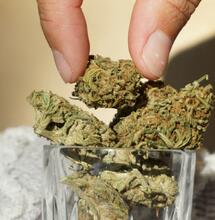Why pH Matters

A bit of science goes a long way in a Cannabis garden. Find out why monitoring and controlling pH levels is essential for healthy plants.
A bit of science goes a long way in a Cannabis garden. Find out why monitoring and controlling pH levels is essential for healthy plants.
|
Invest in a digital pH meter for fast, accurate readings |
Considered one of the most widely-discussed subjects among growers (and also one of the most frequently blamed factors when a grow starts to go bad), what does pH actually measure? Why is it important? Is there a way to grow plants without having to adjust the pH of your nutrient solution? Read on to find the answers to these typical gardening questions.
What is pH, and what does each number on the scale mean?
Put simply, the pH scale is used to measure the acidity or alkalinity of a solution. When you measure pH, you are actually measuring the concentration of hydrogen ions in a solution compared to distilled water (pure water), and the term pH stands for 'potential hydrogen'. The pH scale ranges from '0' to '14', with a reading of '7' being neutral. So, pure water is classed as '7' or neutral, and when you test the pH of a solution you are comparing the amount of hydrogen ions present to this mid-point.
All readings below '7' are considered acidic, and all those above '7' are considered alkaline - although, the technical term is that the solution is 'basic' if it has a pH above '7'.
Every reading (number) on the scale represents an increase or decrease in concentration, to a power of ten. This means that a solution with a pH of '6' is ten times more acidic than a solution with a pH of '7'; anything reading a '5' is one-hundred times more acidic than that '7'; a solution with a pH of '4' is a thousand times more acidic than the solution with a pH of '7'. This is known as an 'exponential logarithmic scale'.
Having an understanding of the differences between numbers is important for a grower. If you soil growers thought it was a pain to keep your pH within a scale of between '5.8' and '6.8' just remember that the fluctuation of one point equates to ten times the acidity or alkalinity.
Why is pH important when growing Cannabis?
A quick and simple answer is that plants can only absorb the full spectrum of nutrients that they require if they are delivered within a certain pH range.
When the pH drops too low the availability of phosphorus decreases significantly, followed by (in no particular order) nitrogen, magnesium, calcium, potassium and sulfur. When the pH rises too high, the availability of iron decreases.
The optimal pH range differs, depending upon your growing method. When growing in soil, the ideal range is just below neutral, between '5.8' and '6.8'; when growing with hydroponics or in cocos, the ideal range is slightly lower, between '5.5' and '6'. Unlike in soil gardens, the pH in a hydroponic solution can fluctuate quickly. This is because soil contains microbial life that help to stabilize the pH, whereas there will be fewer - if any - microbial life present in a hydroponic solution.
How to test pH:
Testing pH is fairly straightforward - you use a pH meter from your local grow shop! In all seriousness, though, it is better to use an accurate tester from your local garden center or hydro store, rather than a cheap little test kit. Forget about the litmus paper from your school-days science class - that was fine for trying to find the difference between lemon juice and baking soda, but the strips will not be adequate for fine-tuning the pH levels of your beloved plants' nutrient solutions.
Reagent tests are inexpensive and very accurate. These involve taking a small sample of the nutrient solution in a test tube and adding a couple of drops of reagent to it. The color of the sample will then change, and you can match the result against a color chart. Quick, simple and cheap, the reagent kits are usually just few bucks at the local grow shop and will often last through to harvesting.
Digital pH meters are the second and much more accurate option; however, they are also more expensive than reagent kits, potentially costing upwards of $50 to $60. They involve placing a measuring probe into the nutrient solution; the meter then measures the pH and shows it as a numeric reading on a digital display. The meters do require some maintenance to keep them operating smoothly - regular cleaning of the probe and calibration of the meter to a set pH point (usually '7') will need to be done a few times throughout the grow. However, this task is definitely worth the effort.
|
Potassium silicate raises pH |
How to change the pH in your grow room or garden:
Should you need to change the pH of your solution, there are some fairly inexpensive options available from your grow shop. To lower your pH, something known as 'pH down' or 'pH minus' is often supplied in the form of phosphoric acid - this will also add an extra dose of phosphorus to your solution. Some of the more advanced pH-reducing products available are a blend of several acids; for example, nitric-, sulfuric- and phosphoric acids prevent too much of an imbalance of one element from occurring.
Natural methods of lowering pH may not produce the exact results you desire, or even work within your desired time frame. For those interested in cultivating just a few Cannabis plants, or a couple of vegetable or fruit shrubs, try researching the old-fashioned methods of using sulfur flowers, coffee grounds, apple cider vinegar, pine needles or lemon juice to lower pH.
The 'pH up' or 'pH plus' products are often potassium hydroxide, which will increase the potassium levels in a solution, in addition to increasing pH. Another good option is potassium silicate, which increases pH while giving a nice dose of silicon to the plants. Conversely to the above natural remedies, natural approaches to making pH more alkaline or basic include an application of lime or crushed egg shells.
Do not feel as if you have to keep your pH extremely exact - in recirculating systems, this will be pretty much impossible. It is certainly acceptable to allow the nutrient solution to hover between '5.8' and '6.8'; in fact, it is fairly common for pH to drift up and down as the plants uptake and deposit certain elements into and out of the solution. Constantly using pH 'up' and 'down' to try to 'fix' or set your pH at '6' will do more harm than good, as you are unbalancing your nutrient solution every time you adjust its pH.
Tips for controlling pH:
- Check the pH of your tap water before adding your nutrients, to reveal your 'background pH'.
- The majority of nutrients and additives on the market will affect pH levels. Add them to your water and mix well before checking pH and feeding your plants. Most base nutrients will bring your pH down, so do not worry if your background pH seems high. It is important to check the reading again, after you have added the nutrients.
- Temperature affects the pH of a solution. Readings rise in colder temps and drop in warmer temps. ALWAYS try to take your pH readings at a similar time during the day; otherwise, any fluctuations could be attributed to the temperature of the solution.
- Relax, just a little. Allowing the pH to fluctuate across the useful range will provide your plants with all of the available elements they need.



